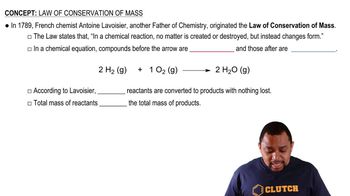Convert each temperature. a. 212 °F to °C (temperature of boiling water at sea level) b. 22 °C to K (approximate room temperature) c. 0.00 K to °F (coldest temperature possible, also known as absolute zero) d. 2.735 K to °C (average temperature of the universe as measured from background black body radiation)
Classify each statement as an observation, a law, or a theory. a. All matter is made of tiny, indestructible particles called atoms. b. When iron rusts in a closed container, the mass of the container and its contents does not change. c. In chemical reactions, matter is neither created nor destroyed. d. When a match burns, heat is released
 Verified step by step guidance
Verified step by step guidance
Verified Solution
Key Concepts
Atoms

Conservation of Mass

Scientific Theories vs. Laws

Express the quantity 254,998 m in each unit. a. km b. Mm c. mm d. cm
Classify each statement as an observation, a law, or a theory. a. Chlorine is a highly reactive gas. b. If elements are listed in order of increasing mass of their atoms, their chemical reactivities follow a repeating pattern. c. Neon is an inert (or nonreactive) gas. d. The reactivity of elements depends on the arrangement of their electrons.
Classify each substance as a pure substance or a mixture. If it is a pure substance, classify it as an element or a compound. If it is a mixture, classify it as homogeneous or heterogeneous. a. sweat b. carbon dioxide c. aluminum d. vegetable soup
Classify each substance as a pure substance or a mixture. If it is a pure substance, classify it as an element or a compound. If it is a mixture, classify it as homogeneous or heterogeneous. a. wine b. beef stew c. iron d. carbon monoxide
